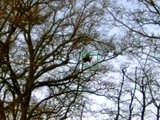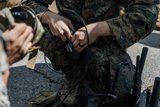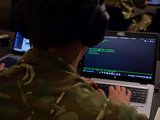Lockheed Martin completes design review for Tactical Reconnaissance and Counter-Concealment Enabled Radar
A synthetic aperture radar system with the capability to operate in all types of weather, day or night, is one step closer to providing warfighters with high resolution reconnaissance imagery. A recent review has concluded that the Lockheed Martin Tactical Reconnaissance and Counter-Concealment Enabled Radar (TRACER) system is acceptable for integration onto manned and unmanned aerial platforms.
"This milestone means that we can soon field this much needed ISR capability to those who need it most," said Jim Quinn, Vice President with Lockheed Martin's Information Systems & Global Services-Defense. "By migrating this advanced sensor technology to unmanned aerial systems and other platforms, we can help warfighters combat contingency operations around the globe."
The Critical Design Review (CDR) focused on the design and integration details associated with the radar's operation on an unmanned aerial system and concluded that the TRACER podded design is acceptable for use on the Predator B platform. The review was conducted for the United States Army Communications-Electronic Research Development and Engineering Center Intelligence and Information Warfare Directorate (I2WD). This successful CDR paves the way for the first flight of TRACER on an unmanned aerial vehicle scheduled for late summer.
TRACER addresses the Army's critical need to detect enemy targets, equipment and facilities under obscuration. Incorporating both a VHF and UHF band within the synthetic aperture radar system, TRACER provides images to ground units in all-weather, day or night conditions. The system also incorporates provisions for a data link that allows airborne processed results to be down-linked to ground stations immediately. The system's design is predicated on Lockheed Martin's proven foliage penetration (FOPEN) technology. FOPEN was developed specifically to detect vehicles, buildings, and large metallic objects in broad areas of dense foliage, forested areas, camouflage netting and wooded terrain.
Source: Lockheed Martin
More from Digital Battlespace
-
![EID to unveil new vehicle communication system at DSEI]()
EID to unveil new vehicle communication system at DSEI
The Portuguese company’s naval communications system is in service across more than a dozen countries. It has turned to its home nation for support in developing a new vehicle based C2 system.
-
![Chess Dynamics successfully demonstrates Vision4ce AI-driven tracker]()
Chess Dynamics successfully demonstrates Vision4ce AI-driven tracker
The Vision4ce Deep Embedded Feature Tracking (DEFT) technology software is designed to process video and images by blending traditional computer vision with artificial intelligence (AI) algorithms to present actionable information from complex environments.
-
![Wave Relay devices cleared for security use on commercial systems in industry trend]()
Wave Relay devices cleared for security use on commercial systems in industry trend
Persistent Systems has been cleared by National Security Agency (NSA) to transmit sensitive data on commercial networks. The devices are added to the NSA’s Commercial Solutions for Classified (CSfC) component list which also includes other companies’ products providing the same security.
-
![UK teases cyber spending boost in Strategic Defence Review ahead of “imminent” release]()
UK teases cyber spending boost in Strategic Defence Review ahead of “imminent” release
The release of the UK’s Strategic Defence Review (SDR) has been long promised as mid-year. It is possible it could be as early as 2 June although the UK Ministry of Defence (MoD) continues to play its cards close to its chest.
-
![Intelsat emphasises SATCOM resilience for SOF in contested domains (video)]()
Intelsat emphasises SATCOM resilience for SOF in contested domains (video)
Intelsat outlines how its multi-orbit SATCOM architecture is enhancing connectivity and resilience for special operations forces operating in degraded and contested environments.
-
![US Space Force’s next-generation missile warning system moves forward with $500 million in new contracts]()
US Space Force’s next-generation missile warning system moves forward with $500 million in new contracts
Next-Generation Overhead Persistent Infrared (Next-Gen OPIR) satellites are intended to provide early warning of missile launches from any location worldwide and new ground stations will result in expanded coverage of critical missile warning.
























